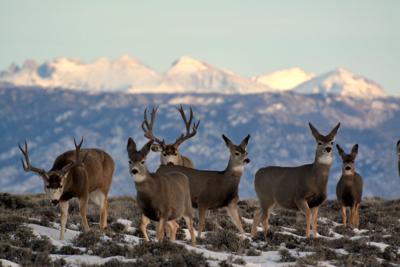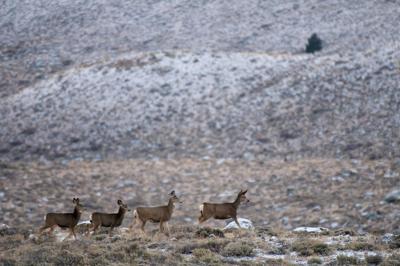A Wyoming mule deer known for migrating farther than any other deer known to science died in Wyoming’s Red Desert.
The nearly 11-year-old deer made headlines for migrating over nearly every year 200 miles.
Mule deer in the spring migrate to higher elevations for richer vegetation and they migrate to lower elevations in the fall to escape the snow.
The Wyoming Migration Initiative reported that a mountain lion attack was the likely cause of death.
Deer 255’s journey
Deer 255 was initially captured by biologists on March 11, 2016, in the Leucite Hills of the Red Desert, roughly 30 miles northeast of Rock Springs.
It is estimated that 255 was born in June 2013.
The name Deer 255 was chosen because she was the 55th animal collared in the second year of a collaborative study between the U.S. Geological Survey, Wyoming Cooperative Fish and Wildlife Research Unit and the Monteith Shop at the University of Wyoming. The Bureau of Land Management and the Wyoming Game and Fish Department also collaborated with the project.
People are also reading…
Deer 255 migrated 150 miles to the Hoback Basin from March to June. She then broke off from the rest of the herd in the basin and migrated an additional 90 miles to Idaho.
Her final 2016 summer range was four miles from Island Park, Idaho — 242 miles from where she started.
Researchers at the time knew of no deer to migrate such a long distance from a winter range to summer range. Across North America, only arctic caribou are known to migrate farther, according to the University of Wyoming.
A malfunction of 255’s GPS collar prior to the start of the 2016 fall migration resulted in a 19-month gap of migration tracking before Deer 255 was rediscovered in March 2018 on Steamboat Mountain by a University of Wyoming doctoral student and crew.
Following her finding, biologists tracked her nearly 3,300 additional miles across seven spring and seven fall migrations.
Deer 255 was last captured in March 2024 for a field check up where biologists learned she was pregnant with twins.

Mule deer are seen migrating in western Wyoming. Game and Fish, along with the University of Wyoming Haub School of Environment and Natural Resources and the Bureau of Land Management, captured, collared and followed 119 adult doe mule deer over a three-year period.
The check up additionally revealed that she had a body fat percentage of 6% — which put her in the top 12% of all animals that spent the past winter near Superior — and a weight of 170 pounds.
Most female mule deer weigh in at roughly 140 pounds.
She died around the noon on April 11, according to GPS collar data.
“In the modern West, where deer often die by disease, habitat loss, starvation, fence entanglement or vehicle collisions, Deer 255 died playing her role as a prey animal in an intact ecosystem,” a press release from the University of Wyoming states.
A migration celebrity
Deer 255’s migrations were made into an animation which garnered substantial interest from the public.
“Animations of her migrations were viewed 3.75 million times across four videos published on social media by the Wyoming Migration Initiative from 2019-2022,” a press release from the University of Wyoming states.
Media outlets additionally wrote numerous stories about Deer 255’s migration.
Researchers suspect that other deer make Deer 255’s record-breaking migration, but her specific migration tactic is rare and has yet to be recorded in any other collared deer, according to a press release from the University of Wyoming. Biologists expect that 255’s record will be broken as migration tracking efforts continue across the West.
Only one other deer, Deer 655, has been known to migrate to Idaho. That deer spent the summer on Teton Pass and made an exploratory movement to near Ririe, Idaho, in 2022.
Why it matters
Long-term research projects focusing on the migration dynamics of the deer have mapped out the routes and importance of protecting migration corridors.
The state of Wyoming in 2016 officially designated the broader Sublette mule deer corridor as “vital habitat,” according to the University of Wyoming.
Mule deer populations across the West are down by 40 percent in the past two decades, according to the University of Wyoming.
Efforts to improve migration corridors in the states are underway with projects to remove fencing and building wildlife crossings over or under state highways.
David Velazquez is a reporter at the Casper Star-Tribune and can be reached at 307-301-0506, or at david.velazquez@trib.com
















